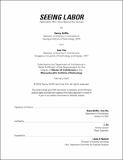Seeing Labor: Fabrication Porn from Behind the Scenes
Author(s)
Griffin, Daniel; Ow, Inez
DownloadThesis PDF (124.9Mb)
Advisor
Jih, J.
Terms of use
Metadata
Show full item recordAbstract
The notion of high-tech oftentimes inadvertently expresses the conviction that industrial progress means the abolition of manual labor from our industry. Within the last 20 years, this veil has been maintained by one prominent body of work in particular: the experimental research pavilion. These 1:1 works allege to be beacons of progress, signaling novel directions for future constructions. Though they are marketed as high-tech, video documentation available on YouTube and Vimeo reveal that they are assembled manually on site, often by large teams of people who receive minimal recognition for the repetitive actions of their bodies. We classify many of these works as “fabrication porn,” semantically hinging upon the similarly exploitative dynamics that exist in the worlds of porn production and theatre stage sets.
Backstage labor has become overwhelmingly disassociated from the very conventions by which we have been trained to present and consume architecture. Plans, sections, elevations, axonometrics, renders and detail drawings — they represent the artifact to be built, but not the actions or subjective experience required to build. When we are able to recognize labor as potential for value-adding, instead of reducing them to semi-automatic manual executions, it becomes clear that labor constitutes a large part of building authorship that the prevailing culture of sensationalism fails to properly credit. Worse still, when operating under this system which thrives on cropping inconvenient realities of labor out of view, we become complicit in propagating abuse, neglect, and injury.
Our thesis recognizes that a more sympathetic relationship between architectural output and labor cannot be realized under the classical model of authorship in architecture, and contends that it is within the agency of the architect to embed labor accounting within the design of the physical artifact itself. We enter our thesis as test subjects in a series of self-administered labor accounting studies, as a way of attuning ourselves to the fact that every architectural design move necessarily implicates bodies. We then propose an architectural take on labor accounting, where physical artifacts serve as ledgers. Our vision: every trace of labor becomes non-fungible — the experience of architectural space and the experience of implicated laborers are rendered inseparable. Seeing Labor is a case that every architect should retrain themselves, to use their role in the organizing of bodies for advocacy, rather than exploitation.
Date issued
2022-02Department
Massachusetts Institute of Technology. Department of ArchitecturePublisher
Massachusetts Institute of Technology